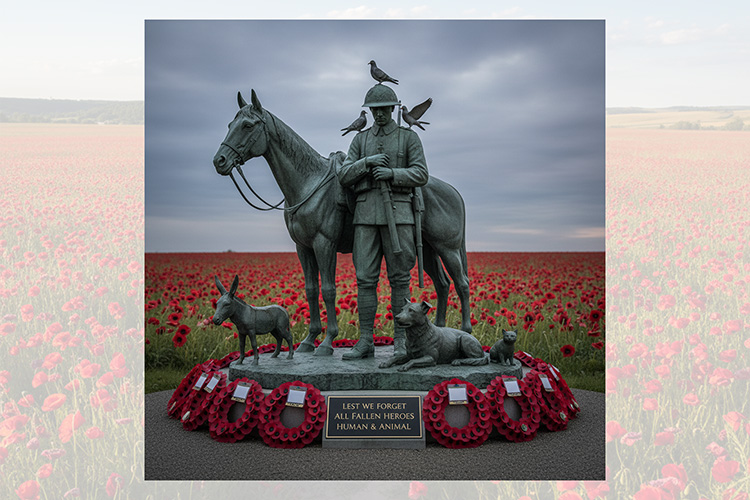
- By Greg
- In Social Value, Community, Construction, Rail
AW GROUP – REMEMBRANCE DAY 2025
Remembrance Day 2025 – World War I, beginning in 1914, stands as one of humanity’s darkest chapters—a conflict of such scale and brutality that it reshaped the world forever. Around nine million soldiers were killed, with over twenty million wounded. Millions more died of disease in the trenches or vanished without trace. Civilian casualties numbered in the tens of millions, as famine, bombardment, and disease ravaged entire nations. For those who survived, life would never return to what it was before.
Yet, amid the human suffering, another tragedy unfolded—one often overlooked. Alongside the soldiers there marched, hauled, and flew an army of animals. More than eight million horses, donkeys, and mules, and over a million dogs, perished during the war. Countless smaller creatures—from pigeons and canaries to cats and goats—also played their part and paid with their lives. Their service, and their suffering, mirror the courage and sacrifice of the men they served beside.
Horses were the engines of the army. They pulled artillery, carried supplies, and charged into battle. But the industrial age had made warfare mechanized and merciless. At the Somme, cavalry charges met machine guns and barbed wire head-on, ending in slaughter. In 1918, during the Battle of Moreuil Wood, 150 horses went into action—only four survived. Horses were conscripted from farms and families across Britain, chosen for strength and stamina.
Many never made it to the front; they died in transit, victims of overcrowded ships, disease, and exhaustion. Those that reached Europe endured cold, hunger, and relentless labour, hauling heavy loads through mud and shellfire.
Injuries were common and care was rudimentary. Illnesses like colic and laminitis ravaged them, and infections festered in untreated wounds. Horses weakened by starvation or disease were often shot where they fell. Even in death, they served—sometimes as food for starving soldiers. When the war ended, only about 6% of the horses sent from Britain came home. The rest were abandoned, sold for slaughter, or left to die. Soldiers who had bonded with their animals were heartbroken, sometimes choosing to end their companion’s life themselves rather than see them suffer.
Dogs too endured the horrors of war. Faithful and intelligent, they served as messengers, guards, medics, and morale-boosters. They carried supplies across terrain impassable to vehicles, detected explosives, warned of enemy advances, and comforted the wounded. In the trenches, dogs offered warmth and companionship to men living in fear and filth. But they shared those same miserable conditions—lice, fleas, hunger, and disease. Many died from infection, mines, or sniper fire. Those that survived were not always spared; as the war ended, many were ordered to be destroyed. A few lucky ones returned home, smuggled back by the men who loved them.
Birds, too, proved indispensable. Around 100,000 homing pigeons carried vital messages when telegraph lines were cut or intercepted. Their success rate exceeded 95%, and harming one was a criminal offense. Some pigeons completed their missions despite being wounded, saving hundreds of lives. Even the humble canary contributed—used in tunnels to detect deadly gases before men entered. Their sensitivity to air quality made them the miners’ silent guardians, often dying to save others.
Other animals—camels, elephants, goats, even cats—served as pack animals, mascots, and companions. Amid the chaos, they offered a rare comfort, a touch of the familiar in a world turned savage.
This November 11th, as we pause to remember those who fell, we must also remember those who served without choice or glory. The millions of men who never came home deserve eternal gratitude, but so too do the voiceless creatures who bore our burdens, faced our enemies, and died alongside us. Their courage was instinctive, their loyalty absolute, and their suffering immense.
Remembrance Day is not only about recalling the past—it is about recognizing sacrifice in all its forms. The red poppy reminds us of the men who fought and fell; the purple poppy honours the animals who served with them.
Together, they tell the full story of war’s cost—a story of courage, compassion, and loss that must never be forgotten.
AW Group is a multi-disciplined construction company providing a broad range of support and manpower across building and rail projects.
Our Fields are:
AW Construction – We offer an outstanding UK-wide fit out service, taking care of everything from scheduling rollouts & ordering materials to assistance with design and onsite delivery
AW Rail – We use the very best labour force and a proactive approach to deliver first-class construction and maintenance projects across the rail industry
AW Labour – We provide a high-calibre blue collar and white-collar workforce with a diverse range of skills, to support the construction and rail industries







